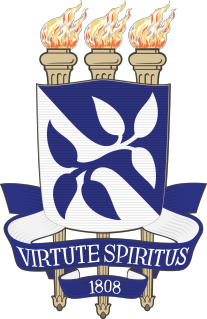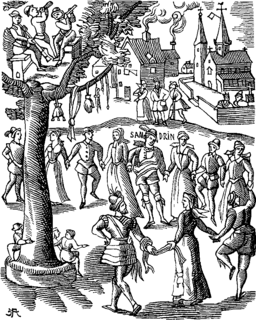
Bahia is one of the 26 states of Brazil and is located in the northeastern part of the country on the Atlantic coast. It is the 4th-largest Brazilian state by population and the 5th-largest by area. Bahia's capital is the city of Salvador, located on a spit of land separating the Bay of All Saints from the Atlantic. Once a monarchial stronghold dominated by agricultural, slaving, and ranching interests, Bahia is now a major manufacturing center whose last three elections have been dominated by the Workers' Party.

The Carnival of Brazil is an annual Brazilian festival held between the Friday afternoon before Ash Wednesday and Ash Wednesday at noon, which marks the beginning of Lent, the forty-day period before Easter. During Lent, Roman Catholics and some other Christians traditionally abstained from the consumption of meat and poultry, hence the term "carnival", from carnelevare, "to remove meat."
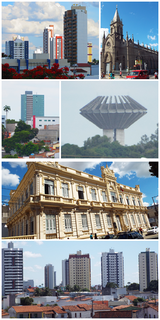
Feira de Santana is a city in Bahia, Brazil. It is the second-most populous city in the state, with a population of 612,000 according to IBGE's estimate. It is located 100 km northwest of Salvador, Bahia's capital city. These cities are connected by BR-324, a four-lane divided highway.
Nélson Correia de Araújo was a Brazilian writer. He was a renowned author of numerous books on the history and people of Brazil, writer, publisher, copyholder, translator, photographer, journalist, reporter, folklore researcher and a professor the History of Theater at the Universidade Federal da Bahia (UFBA).

Barra da Tijuca is a neighborhood or bairro in the West Zone of Rio de Janeiro, Brazil, located in the western portion of the city on the Atlantic Ocean. Barra is well known for its beaches, its many lakes and rivers, and its lifestyle. This neighbourhood represents 4.7% of the city population and 13% of the total area of Rio de Janeiro.

Bahian Carnival is the annual carnival festival celebrated in the Brazilian state of Bahia, mainly in its capital, Salvador. The event lasts officially for six full days: it starts on a Thursday, then follows the usual five days of carnival. The term may also be used to comprise related events that happen immediately before or after the carnival in Bahia. Therefore, extending the duration for up to twelve days.

The Historic Center (US) or Centre of Salvador de Bahia in Brazil, also known as the Pelourinho or Pelo, is a historic neighborhood in western Salvador, Bahia. It was the city's center during the Portuguese colonial period and was named for the whipping post in its central plaza where African slaves received punishment for various infractions, as well as for disciplinary purposes. The Historic Center is extremely rich in historical monuments dating from the 17th through the 19th centuries.

Rio Vermelho is a neighborhood in the southern zone of Salvador, Bahia. It is located between the neighborhoods of Ondina and Amaralina, and south of Engenho Velho da Federação, Santa Cruz, and Nordeste de Amaralina. Rio Vermelho is noted for its beaches, notably Buracão, Mariquita, Santana, Paciência, and Sereia.

September Seven Avenue colloquially known as Seven Avenue is an important road in the city of Salvador, Bahia, Brazil. It starts at the Farol da Barra, Barra (Neighborhood), and ends at Castro Alves Square, Historic Centre.
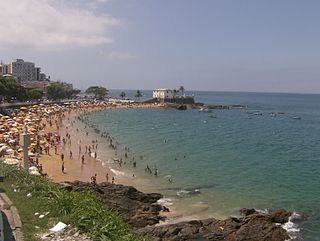
Porto da Barra Beach is located in Barra neighborhood in the city of Salvador, Brazil. It is located at the entrance of the Baía de Todos os Santos, with a small, white colonial fort at one end and a whitewashed church sitting up on a hill at the other.

Madre de Deus is a municipality in the state of Bahia in the North-East region of Brazil. The municipality is located on a small archipelago in the Bay of All Saints; it both the smallest municipality by land mass in Bahia and the Northeastern region of Brazil. Madre de Deus is spread across two islands, the Ilha de Madre de Deus and the much smaller Ilha de Maria Guarda. It sits in close proximity to two others islands, the Ilha do Bom Jesus dos Passos and Ilha dos Frades, both part of the city of Salvador. The Ilha de Madre de Deus is further subdivided into the neighborhoods of Centro, Suape, Cação, Marezinha, Mirim, Alto do Paraíso, Apicum, Nova Madre de Deus e Quitéria, Alto da Matriz, Alto do Santo Antônio, Alto da Boa Vista, Cururupeba, Malvinas, and Nova Brasília.
Born in Salvador, Bahia, Yeda Pessoa de Castro is a Brazilian ethnolinguist. With a Phd. in African Languages at the National University of Zaire, she is a Technical Consultant in African Languages for the Museu da Língua Portuguesa at the Estação da Luz in São Paulo, a Member of the Academia de Letras da Bahia and of the ANPOLL's GT de Literatura Oral e Popular. Also is a Permanent Member of the Brazilian Scientific Committee of the Project "Slave Route" by UNESCO.
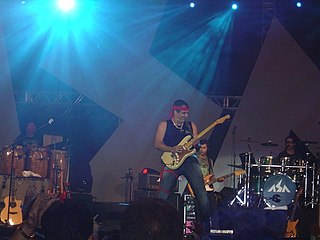
Durval Lélys is a Brazilian musician, singer-songwriter, multi-instrumentalist and lyricist. He is best known as the frontman of the Salvador (Brazil)-based axé band Asa de Águia. Durval is well known as being one of the main personas from the Brazilian carnival.
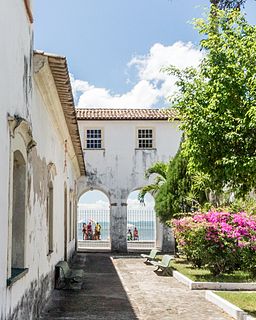
The Church of Our Lady of Penha is an 18th-century Roman Catholic church in Salvador, Bahia, Brazil. The church is located in the Ribeira neighborhood and constructed in 1742 as an extension of the Summer Palace of the Archbishop of the Roman Catholic Archdiocese of São Salvador da Bahia. The church sits at the end of the Itapagipe Peninsula and faces the Bay of All Saints. The Church of Our Lady of Penha was listed as a historic structure by the National Historic and Artistic Heritage Institute in 1941.

Comércio is a neighborhood of Salvador, Bahia, Brazil. The district served as the port of entry to Salvador from the beginning of the colonial period and later became home to the first planned business district in Brazil. It remains a financial center in the state of Bahia, as well as a municipal transportation hub and tourist destination. Comércio is home to numerous national heritage sites dating from the early colonial period to the 20th century. Comércio as a whole was listed as a national historic district of Brazil by the National Institute of Historic and Artistic Heritage in 2008.





